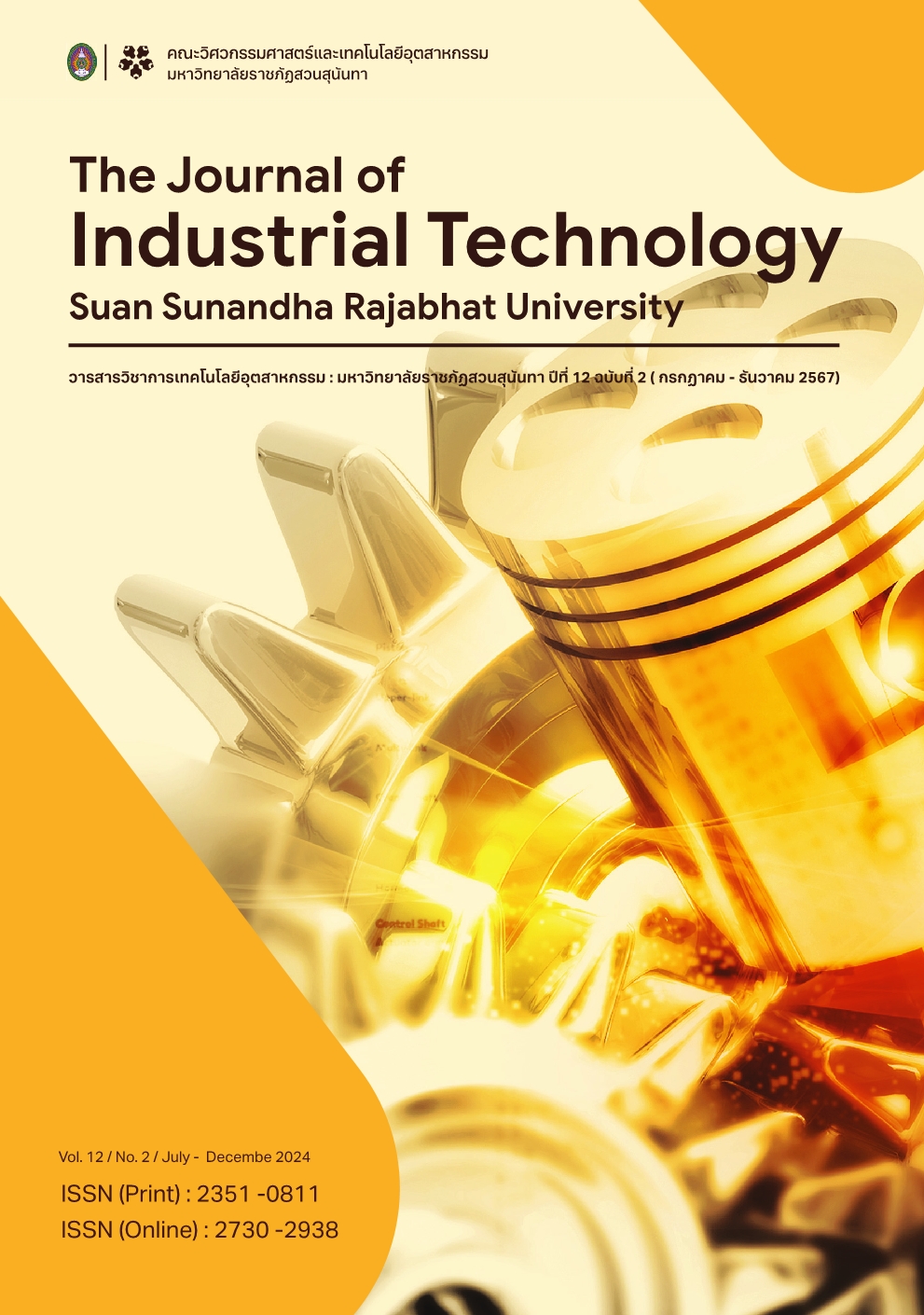การวิเคราะห์ปริมาณการปล่อยก๊าซคาร์บอนไดออกไซด์จากพฤติกรรม การขับขี่รถยนต์ด้วยวิธีการถดถอยเชิงเส้นแบบพหุคูณ กรณีศึกษาบริษัทตัวอย่าง
คำสำคัญ:
พฤติกรรมการขับขี่, การวิเคราะห์การปล่อยไอเสียของยานพาหนะ, การปล่อยคาร์บอนไดออกไซด์, การเลือกตัวแปรโดยวิธีลดตัวแปร, การวิเคราะห์การถดถอยบทคัดย่อ
ในประเทศไทย ภาคการขนส่งเป็นกิจกรรมหลักที่ปล่อยก๊าซคาร์บอนไดออกไซด์ ซึ่งการเผา ไหม้เชื้อเพลิงในเครื่องยนต์เป็นปัจจัยสำคัญที่ก่อให้เกิดก๊าซเรือนกระจกที่ก่อให้เกิดภาวะโลกร้อน ดังนั้น การศึกษานี้ต้องการศึกษาปริมาณการปล่อยก๊าซคาร์บอนไดออกไซด์จากพฤติกรรมการขับขี่รถยนต์ใน การจัดส่งสินค้าของบริษัทตัวอย่าง รวบรวมข้อมูลโดยใช้เครื่องมือ GPS Tracker ซึ่งติดตั้งบน ยานพาหนะสำหรับจัดส่งสินค้าของบริษัทตัวอย่าง จากนั้นทำการวิเคราะห์ข้อมูลโดยวิธีการถดถอยเชิง เส้นแบบพหุคูณ ด้วยวิธีการเลือกตัวแปรโดยวิธีลดตัวแปรเพื่อตรวจสอบความสัมพันธ์ระหว่างพฤติกรรม การขับขี่และการปล่อยก๊าซคาร์บอนไดออกไซด์ และสมการสำหรับปริมาณการปล่ อยก๊าซ คาร์บอนไดออกไซด์ ผลการศึกษาพบว่าปริมาณการปล่อยก๊าซคาร์บอนไดออกไซด์เพิ่มขึ้นตามระยะเวลา การทำงานของเครื่องยนต์ การเร่งความเร็วกะทันหัน การชะลอความเร็วกะทันหัน และกรณีเกิน ขีดจำกัดความเร็ว ได้แก่ 0.004418 KgCo2eq/นาที 0.04067 KgCo2eq/ครั้ง 0.2531 KgCo2eq/ครั้ง และ 0.02024 KgCo2eq/ครั้ง ตามลำดับ นอกจากนี้ ยังได้เสนอแนวทางการควบคุมพฤติกรรมการขับขี่ เพื่อลดการปล่อยก๊าซคาร์บอนไดออกไซด์และลดความเสี่ยงที่เกิดจากพฤติกรรมการขับขี่อีกด้วย
References
Environmental Protection Agency. “Climate Change Indicators: Green house Gases,” December. 1, 2023. [Online]. Available: https://www.epa.gov/climateindicators/greenhouse-gases
The Intergovernmental Panel on Climate Change. “ Climate Change 2021: The Physical Science Basis,” December. 1, 2023. [Online]. Available: www.ipcc.ch/assessment-report/ar6
United Nations Thailand. “Cause and Effects of Climate Change,” December. 1, 2023. [ Online] . Available: https://thailand.un.org/en/174652-causes-and-effects-climate-change
N. Panmanee, “ N. P. Thailand’ s Carbon Neutrality & Net Zero GHG Emission,” Academic Conference of the Thailand Research Fund ( TRF) year 2022, The 60th Anniversary Research Science Building, Chulabhorn Research Institute Kasetsart University Thailand, December. 17, 2022.
T. Yaanan, “Climate Change Action of Thailand: Case Study of the 26thsession of the Conference of the Parties (COP26) of the United Nations Framework Convention on Climate Change (UNFCCC),” Ramkhamhaeng Journal, 2022, vol. 11, no. 1, pp. 69-108.
Energy Policy and Planning Office, Ministry of Energy Thailand. “National Energy Plan,” December. 2, 2023. [Online] . Available: https://www.eppo.go.th/epposite/index.php/th/petroleum/oil/link-doeb/item/17093-nep
Thansettakij. “Thai EV Market: Trend or Reality,” December. 2, 2023. [Online]. Available: https://www.thansettakij.com/blogs/columnist/setsawana/569222
L. Zhang, T. Zhang, K. Peng, X. Zhao and Z. Xu, “Can autonomous vehicles save fuel? Findings from field experiments,” Journal of Advanced Transportation, vol. 1, p. 2631692, July. 2022.
Y. Huang, “ Impact of drivers on real- driving fuel consumption and emissions performance,” Science of The Total Environment, vol. 798, 2021.
G.M. Hasan Shahariar, “Impact of driving style and traffic condition on emissions and fuel consumption during real- world transient operation,” Fuel, vol. 319, 2022.
S. Songsittidet and S. Junsri, “ Study on Fuel Usage of Refrigerated Pickup Trucks: A Case Study of Tatong Company Limited, Nakhon Sawan,” Industrial Technology and Engineering Pibulsongkram Rajabhat University Journal, vol. 2, no. 3, pp. 11-20, September. 2020.
D.C. Montgomery, E.A. Peck, And G.G. Vining, New Jersey: John Wiley & Sons, 2012.
P. Ping, “ Impact of Driver Behavior on Fuel Consumption: Classification, Evaluation and Prediction Using Machine Learning”, Journal of IEEE Access, vol. 7, June 2019.
Downloads
เผยแพร่แล้ว
How to Cite
ฉบับ
บท
License
Copyright (c) 2024 คณะวิศวกรรมศาสตร์และเทคโนโลยีอุตสาหกรรม มหาวิทยาลัยราชภัฎสวนสุนันทา

This work is licensed under a Creative Commons Attribution-NonCommercial-NoDerivatives 4.0 International License.
บทความที่ได้รับการตีพิมพ์เป็นลิขสิทธิ์ของคณะวิศวกรรมศาสตร์และเทคโนโลยีอุตสาหกรรม มหาวิทยาลัยราชภัฎสวนสุนันทา
ข้อความที่ปรากฏในบทความแต่ละเรื่องในวารสารวิชาการเล่มนี้เป็นความคิดเห็นส่วนตัวของผู้เขียนแต่ละท่านไม่เกี่ยวข้องกับมหาวิทยาลัยราชภัฎสวนสุนันทา และคณาจารย์ท่านอื่นๆในมหาวิทยาลัยฯ แต่อย่างใด ความรับผิดชอบองค์ประกอบทั้งหมดของบทความแต่ละเรื่องเป็นของผู้เขียนแต่ละท่าน หากมีความผิดพลาดใดๆ ผู้เขียนแต่ละท่านจะรับผิดชอบบทความของตนเองแต่ผู้เดียว







